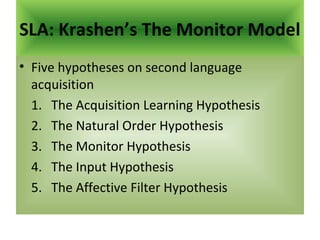
Krashen's Hypotheses on L2 Acquisition
- 1. SLA: Krashen’s The Monitor Model • Five hypotheses on second language acquisition 1. The Acquisition Learning Hypothesis 2. The Natural Order Hypothesis 3. The Monitor Hypothesis 4. The Input Hypothesis 5. The Affective Filter Hypothesis
- 2. 1. The Acquisition Learning Hypothesis – applicable to the process of: Internalizing new L2 knowledge (acquisition vs. learning) Storing such knowledge (acquired knowledge for automatic processing and learnt knowledge for controlled processing) Using in actual performance (acquired knowledge as the major source of initiating both the comprehension and production of utterances) *learnt knowledge for use only by the Monitor
- 3. 2. The Natural Order Hypothesis - learners may follow a more or less invariant order in the acquisition of formal grammatical features Affirms that grammatical structures are ‘acquired’ in a predictable order. When the learner is engaged in natural communication tasks, he will manifest the standard order. But when the task requires or permits the use of metalinguistic knowledge, a different order will emerge.
- 4. 3. The Monitor Hypothesis – the device that learners use to edit their language performance Utilizes ‘learnt knowledge by acting upon and modifying utterances generated from ‘acquired’ knowledge either before or after the utterance, albeit optional. Has limited function in language performance even with adults Conditions for its use: sufficient time; form-focused; user’s knowledge of the rule *Editing (by ‘feel’) can take place using ‘acquired’ competence (but not developed).
- 5. 4. Input Hypothesis – ‘acquisition’ takes place as a result of the learner having understood input that is a little beyond the current level of his competence (i.e. the i + 1 level ) Input that is comprehensible to the learner will automatically be at the right level.
- 6. 5. The Affective Filter Hypothesis - how affective factors relate to SLA and the ground of the Acculturation Model As proposed by Dulay and Burt (1977), the filter controls how much input the learner comes into contact with, and how much input is converted into intake. It’s affective as its strength is determined based on: motivation self-confidence anxiety state
- 7. • Causative Variables Taken into Account in the Monitor Model 1. Aptitude While attitude is related to ‘acquisition, aptitude only relates to ‘learning’. 2. Role of the first language The first language does not interfere with SLA but rather serves as a performance strategy. 3. Routines and patterns Formulaic speech (consisting of routines and patterns) does not contribute to ‘acquisition’.
- 8. 4. Individual differences There is no variation in the acquisition process itself, but there is in: 1. the rate and the extent acquisition as a result of the amount of comprehensible input received, and the strength of the Affective Filter 2. performance, brought about by the extent of the learner’s reliance on ‘learnt’ knowledge. 3 types of Monitor Users: 1. over-users 2. under-users 3. optimal users (i.e. Those who apply conscious knowledge when it is appropriate.
- 9. 5. Age affects the amount of comprehensible input that is obtained influences the affective state of the learner After puberty the Affective Filter is likely to increase in strength. Younger learners may get more than older learners. Age also affects ‘learning’; older learners are better in studying language form and using ‘learnt’ knowledge in monitoring.
- 10. • Three Central Issues of the Monitor Model 1. The ‘Acquisition-Learning’ Distinction unreliable due to how the distinction is defined (McLaughlin, 1978) unacceptable as it cannot be tested in empirical investigation Contrary to what non-interface position suggests, ‘learnt’ knowledge automatized through practice becomes ‘acquired’ i.e. available for use in spontaneous conversation. (McLaughlin, 1978 et.al.) no explanation about what the learner does with the input (Larsen-Freeman, 1983b)
- 11. 2. Monitoring does not account for the reception of utterances, collaborative activity between the learner and his interlocutor, and detailed discussion of how ‘learning’ takes place only limited to syntax (overlooking learners and users ability to edit their pronunciation, lexis and discourse. It is difficult to distinguish introspectively ‘rule’ application and ‘feel’ (the implicit use of ‘acquired’ knowledge to judge or modify an utterance). We are able to attend to the form of our utterances without using conscious rules, and without being able to make explicit how modifications in the initial output have been affected.
- 12. 3. Variability The ‘dual competence’ theory of SLA is questionable as learners produce utterances which are formally different even when it is evident that they are focused on meaning (an evidence is cited in Ellis’s, 1984b reference to a bingo game) The aspects of a single but variable competence which contains alternative rules for realizing the meanings should be considered
